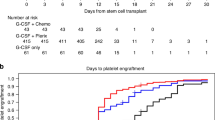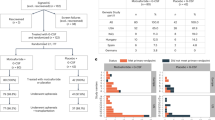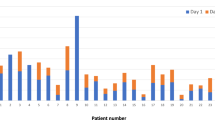Abstract
The aim of the study was to evaluate peripheral blood progenitor cell mobilization by disease-specific chemotherapy in heavily pretreated patients with germ cell tumor (GCT), scheduled for high-dose chemotherapy. Thirty-four consecutive patients, 29 males and five females, with advanced GCT referred to our department for high-dose chemotherapy were evaluated retrospectively. Sixteen patients were mobilized by vinblastine 0.11 mg/kg on days 1 and 2, ifosfamide 1200 mg/m2 days 1–5 and cisplatin 20 mg/m2 days 1–5 (VeIP). In 10 patients, etoposide 75 mg/m2 days 1–5 was used instead of vinblastine (VIP), while in eight patients the mobilization was attempted by administering 7 g/m2 of cyclophosphamide. The choice of either etoposide or vinblastine was predicated upon which of these two drugs was associated with best results during premobilization chemotherapy. Cyclophosphamide was selected in patients refractory to previous cisplatin-based salvage chemotherapy. Twenty-five out of 34 patients underwent a successful PBPC collection. In 17 of them one leukapheresis procedure was sufficient to collect the target number of CD34+ cells, while in eight patients a double procedure was necessary. Altogether 33 aphereses were performed in 25 patients. In nine patients leukapheresis was not attempted. This was due to the fact that the chemotherapy failed to mobilize the target number of CD34+ cells in eight of them, treated with the VeIP mobilizing regimen, while one patient treated with high-dose cyclophosphamide rapidly progressed during therapy and for this reason leukapheresis was not undertaken. In conclusion, in heavily pretreated patients with GCT, PBPC mobilization is feasible by a further course of salvage chemotherapy. The choice of either etoposide (VIP) or vinblastine (VeIP) can be predicated upon which of these two drugs was associated with best results during premobilization chemotherapy. In our hands, VeIP seems to be less satisfactory as mobilizing treatment than VIP, possibly due to a superior number of premobilization courses of chemotherapy in some patients. Moreover, high-dose cyclophosphamide remains a good alternative for mobilizing patients refractory to salvage chemotherapy.
This is a preview of subscription content, access via your institution
Access options
Subscribe to this journal
Receive 12 print issues and online access
$259.00 per year
only $21.58 per issue
Buy this article
- Purchase on SpringerLink
- Instant access to full article PDF
Prices may be subject to local taxes which are calculated during checkout
Similar content being viewed by others
Author information
Authors and Affiliations
Rights and permissions
About this article
Cite this article
Dazzi, C., Cariello, A., Rosti, G. et al. Peripheral blood progenitor cell (PBPC) mobilization in heavily pretreated patients with germ cell tumors: a report of 34 cases. Bone Marrow Transplant 23, 529–532 (1999). https://doi.org/10.1038/sj.bmt.1701622
Received:
Accepted:
Published:
Issue date:
DOI: https://doi.org/10.1038/sj.bmt.1701622
Keywords
This article is cited by
-
A randomized study comparing filgrastim versus lenograstim versus molgramostim plus chemotherapy for peripheral blood progenitor cell mobilization
Bone Marrow Transplantation (2006)
-
Long-term follow-up of patients with poor prognosis germ cell tumor treated with early high-dose chemotherapy with hematopoietic progenitor cell support: a single-center experience
Bone Marrow Transplantation (2004)



